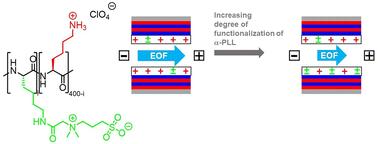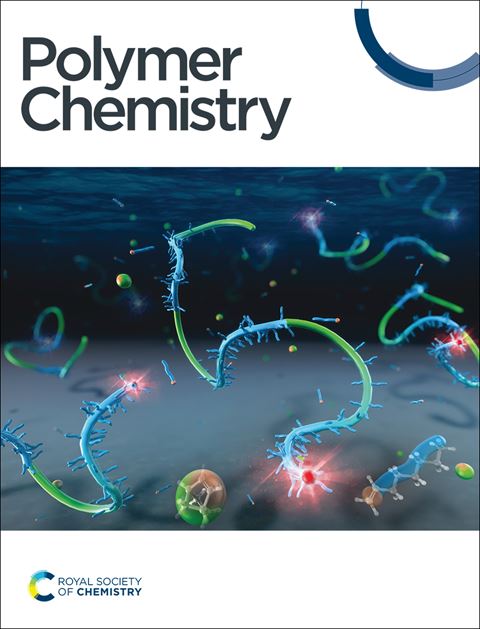Adjusting the electroosmotic flow for CE separation of proteins by using poly(α-l-lysine)-based mixed polycationic/polyzwitterionic multilayer coatings†
IF 3.9
2区 化学
Q2 POLYMER SCIENCE
引用次数: 0
Abstract
Capillary electrophoresis (CE) is a robust, selective and highly efficient technique for the analysis of peptides and (intact) proteins. The anionic and/or hydrophilic character of the fused silica surface generally leads to protein adsorption by electrostatic interaction or H-bonding. Successive multiple ionic-polymer layer (SMIL) coatings are often used to limit adsorption and to improve the repeatability of migration times. Besides these adsorption phenomena, the electroosmotic flow (EOF) also has a strong influence on the resolution. Here, the frequently used and efficient cationic SMIL coating agent poly(α-l-lysine) (α-PLL) is modified for the systematic modulation of the EOF. In particular, by converting stepwise the ε-amino functions of this polycation into carboxamides, the total number of positive charges decreases, leading to reduced EOF. To simultaneously keep the analyte–surface interactions as small as possible, carboxylic acids bearing a zwitterionic functionality based structurally on a sulfobetaine motif were developed. Using the water-soluble and highly hydrolysis-resistant condensation agent 4-(4,6-dimethoxy-1,3,5-triazin-2-yl)-4-methylmorpholinium chloride (DMTMM), the degree of functionalization could be adjusted between 8 and 99%, depending on the applied stoichiometry. The obtained set of mixed polycationic/polyzwitterionic polymers based on the α-PLL scaffold were investigated as the outermost layers of the SMIL coatings, clearly showing that the EOF decreases depending on the degree of functionalization while maintaining high efficiency.

混合聚阳离子/多两性离子聚(α- l -赖氨酸)基多层膜对蛋白质CE分离电渗透流量的调节
毛细管电泳(CE)是一种稳定、选择性和高效的多肽和(完整)蛋白质分析技术。熔融二氧化硅表面的阴离子和/或亲水性通常导致蛋白质通过静电相互作用或氢键吸附。连续的多离子聚合物层(SMIL)涂层通常用于限制吸附和提高迁移次数的可重复性。除了这些吸附现象外,电渗透流(EOF)对分辨率也有很大的影响。本文对常用的高效阳离子SMIL涂层剂聚α- l -赖氨酸(α-PLL)进行了改性,以实现EOF的系统调制。特别是,通过将这种多阳离子的ε-氨基官能团依次转化为羧酰胺,正电荷总数减少,导致EOF降低。为了同时使分析物与表面的相互作用尽可能小,在结构上基于磺胺甜菜碱的动机,开发了具有两性离子功能的羧酸。使用水溶性和高度抗水解缩合剂4-(4,6-二甲氧基-1,3,5-三嗪-2-基)-4-甲基氯胺(DMTMM),根据应用的化学计量,功能化程度可以在8%到99%之间调节。以α-PLL支架为基础,研究了制备的聚阳离子/聚两性离子混合聚合物作为SMIL涂层的最外层,结果表明,EOF随功能化程度的增加而降低,同时保持了较高的效率。
本文章由计算机程序翻译,如有差异,请以英文原文为准。
求助全文
约1分钟内获得全文
求助全文
来源期刊

Polymer Chemistry
POLYMER SCIENCE-
CiteScore
8.60
自引率
8.70%
发文量
535
审稿时长
1.7 months
期刊介绍:
Polymer Chemistry welcomes submissions in all areas of polymer science that have a strong focus on macromolecular chemistry. Manuscripts may cover a broad range of fields, yet no direct application focus is required.
 求助内容:
求助内容: 应助结果提醒方式:
应助结果提醒方式:


